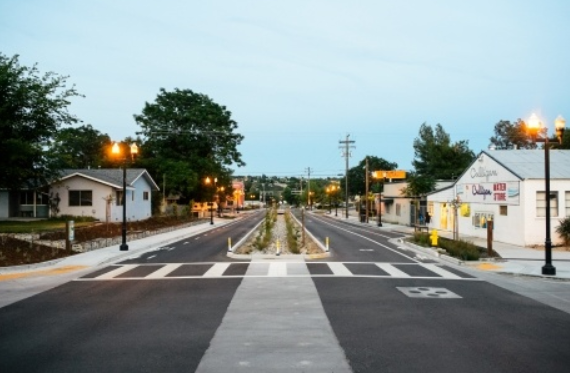Case Study Information
Overview
LOCATION: 21st Street between Vine Street and Riverside Avenue, Paso Robles, CA
FEATURES: Bioretention, permeable pavers, reduction of impervious surfaces, native drought tolerant landscape, structural soils in tree root zone, recycled and repurposed materials
DESIGN TEAM: Low Impact Development Initiative, SvR Design, Cannon Corporation, Earth Systems Pacific Geotechnical
CONTACT: Ditas Esperanza, City of Paso Robles, (805) 237-3861, cipengineering@prcity.com
The 21st Street project, completed in spring of 2014, is located in the heart of Paso Robles, California.
This project includes commercial and residential frontage properties, redesigned as a complete/green street corridor that meets sustainable infrastructure performance objectives while delivering a myriad of community benefits.
Background
In the past, 21st Street experienced frequent and significant flooding, poor pavement conditions, and inadequate facilities for bicycle and pedestrian traffic. To remedy this, the City of Paso Robles, in partnership with the Central Coast Low Impact Development Initiative and SvR Design Company, developed a conceptual design for a green/complete street.
The City received an Urban Greening Grant and, with additional City funds, made the project a reality.
Key Elements
The project design for stormwater management is unique in that flows from Mountain Springs Creek are addressed separately from polluted runoff from impervious surfaces immediately adjacent to, and including, 21st Street. Flows from Mountain Springs Creek are directed down a central vegetated channel, while runoff from streets and other impervious surfaces are managed in a series of bioretention planters where runoff volumes and pollutants are captured, treated and infiltrated.
Additional benefits of the project include:
- Three quarters of a mile of new bike lanes and ADA pathways
- Improved pedestrian safety at intersections and the railroad crossing
- Traffic calming
- Pedestrian amenities such as seating areas, interpretive signage, art, and bike racks
- 81 new trees and a low water-use, native-plant landscape





